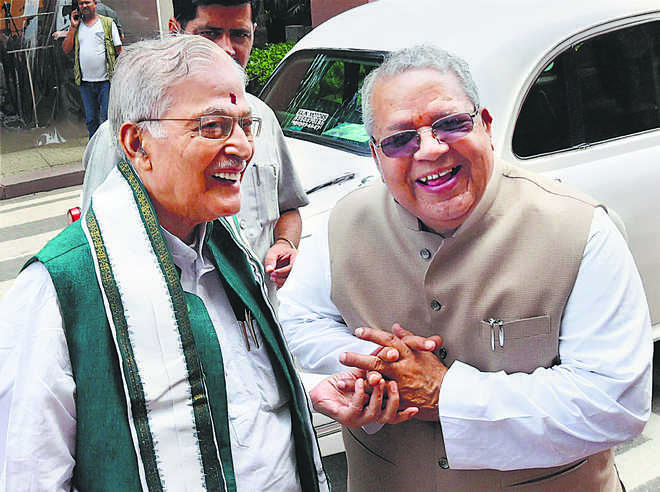UP’s changing caste equations
Saba Naqvi
Uttar Pradesh is a state with the demographic peculiarity of upper castes constituting nearly 20 per cent of the population of which half are Brahmins. It is home to the largest numbers of Brahmins in the country that constitute 10 per cent of the state's population. The BJP swept UP in the 2014 General Election and the 2017 Assembly poll with the support of all sections (excluding the 20 per cent minorities), including those who are at the top of the Varna system.
But I would argue that today the BJP is the party of Backward Castes and Thakurs and not Brahmins in Uttar Pradesh. Let's look at the list of BJP Chief Ministers in Uttar Pradesh. One OBC (Kalyan Singh) and two Thakurs (Rajnath Singh and Adityanath Yogi). No Brahmin. And in 2019, the two most significant Brahmin leaders of the BJP from the state have been retired: Kalraj Mishra and Murli Manohar Joshi. Yet there is a Hindi heartland perception of the BJP as the "real" Brahmin party. This comes from a traditional perception of the RSS and Jana Sangh, precursor to the BJP (that was founded in 1980) as being at its core a force that combined the strategic intelligence of the Brahmin with the purse-string network of Baniya shopkeepers.
True, the RSS is dominated by Maharashtrian Brahmins and the Chief Minister of that state Devendra Fadnavis is a Brahmin. But in Uttar Pradesh, there appears to be no possibility of Brahmins taking the mantle of leadership. Indeed, since Adityanath Yogi's elevation, Brahmins complain of him propagating "Thakurvaad" a term that means, according to a veteran BJP hand, that he promotes Thakur strongmen while ignoring the "strategically wiser" Brahmins. The real base, off course, now lies in the non-Yadav OBCs, numerically the largest chunk of the state's population.
Indeed, I would argue that the promotion of OBCs is actually a sign of the BJP's health. After the Mandal upsurge the BJP did some deft social engineering to position OBC leaders such as Kalyan Singh in Uttar Pradesh and Uma Bharati in Madhya Pradesh. Eventually, even a figure such as Narendra Modi was positioned as Chief Minister. He went on to become the Prime Minister because the OBC tag was an advantage, besides his own ambition and strategic intelligence.
In contrast, in the era when it was the most significant force in Uttar Pradesh, the Congress did not have the capacity to look beyond Brahmins. The Congress of that era only turned to Brahmins for leadership positions and would rarely look lower in the Varna pecking order. Congressman Kamalapati Tripathi, one of the Brahmin doyens of the party, would become CM for two years from 1971 to 1973. When his government fell over a revolt by the police, another Brahmin from Garhwal, Hemwati Nandan Bahuguna became Chief Minister in November 1973. He lasted till 1975 but then was pushed out due to differences with Indira Gandhi's son Sanjay Gandhi. A third Brahmin, this time from Kumaon, ND Tiwari became Chief Minister at the time when Indira had imposed the Emergency.
When the Janata Party won the Lok Sabha elections in 1977, the ND Tiwari government in UP was sacked. But by 1980, the Congress was back to primacy in Uttar Pradesh. Now, besides Brahmins, it began elevating another forward caste, the Thakurs and VP Singh became CM. In 1982, he resigned and another Brahmin, Shripati Mishra, ruled for two years, till 1984 when ND Tiwari was brought back for another tenure as CM. He was in the chair when Indira was assassinated after which the Congress swept again. Rajiv Gandhi would by 1985 replace him with Vir Bahadur Singh, a Thakur leader from Gorakhpur (where current UP CM Adityanath Yogi heads a religious order). Singh got nearly three years but was replaced by ND Tiwari, under whom the Congress was defeated in 1989.
After that the Congress has never formed a government in Uttar Pradesh. Let us also reinforce the fact that even in the age of Congress hegemony, India's largest state was never a cakewalk for the party. The Jana Sangh, the socialists, the peasant forces led by Charan Singh with bases in western Uttar Pradesh, were active in UP for over half a century.
We can ask the question whether the Congress' atrophy in the face of the Mandal transformation was due to the party never showing the capacity to look beyond Brahmins and Thakurs: in eight years, between 1980 and 1988, the Congress national leadership changed the chief ministers six times, choosing between the two forward castes. In 2019, the Congress strategic design is apparently incumbent on Brahmins of eastern UP, returning to the party, that is their natural home. Nobody knows whether it will happen or whether the Brahmins of the state have decided that strategic wisdom lies in supporting Modi and Yogi.









